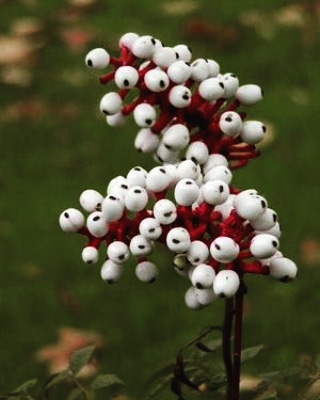White Baneberry (Actaea Pachypoda) is a flowering plant found in the eastern part of North America. In early spring the plant appears quite normal. But as the season progresses the pretty flowers give way to small white berries each with a striking black pupil,
perched on top of red stalks that look uncannily like an optic nerve. Hence the plant’s other name; the Doll's Eyes.
Doll’s Eyes are not very common in the wild. Almost alien looking when encountered in the shady forests and hillsides in which they live, the bush can spread out to about 2 feet tall and 3 feet wide.
All components of the plant - stems, leaves and roots - are considered poisonous to humans and symptoms include burning of the throat, uncontrollable salivation, severe stomach cramps, vertigo and hallucinations.
This is particularly true of the berries which contain cardiogenic toxins; eating just 6 of them has an immediate sedative effect on human cardiac muscle tissue. Ingesting larger amounts can lead to cardiac arrest and death.
Fittingly Baneberry is from the Old English words bana or bona, which both mean ‘slayer’ or ‘murderer.’
Get yourself a good kitchen witch however and the Doll’s Eyes plant can have all sorts of restorative uses. It has long been used to relieve pain associated with childbirth, pre-menstrual cramps, and as a general treatment for the common cold.
Homeopathic cures are usually administered by brewing tea from the roots, meaning the strength cannot easily be monitored. So one for only the experienced herbalist!
#folkhorror #dollseyes #baneberry #herbalism #kitchenwitch #gardenwitch #botanicals #weirdnature #homeopathy #hallucinogens

 Read on Twitter
Read on Twitter


